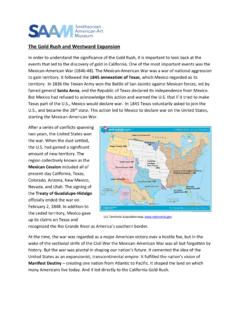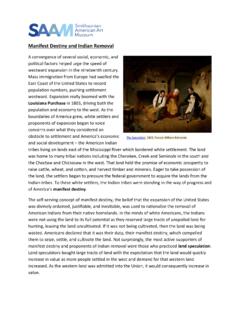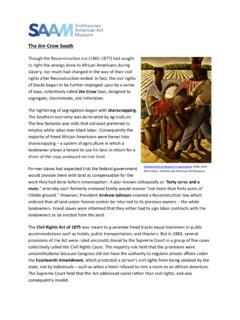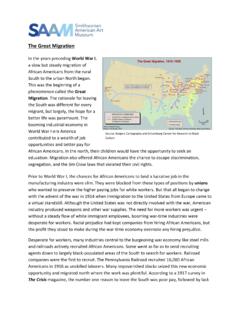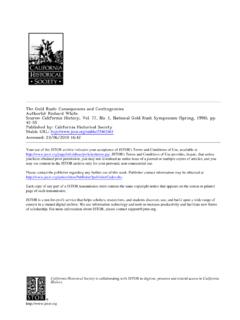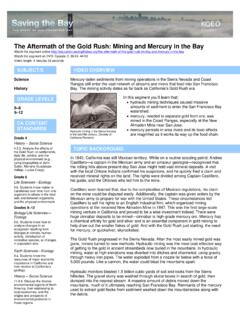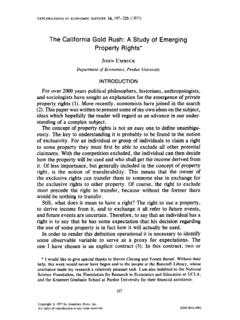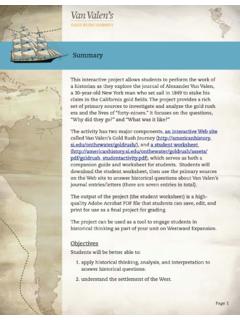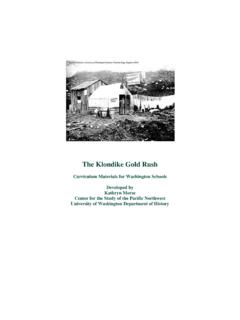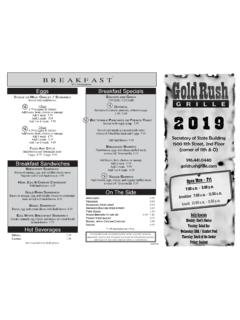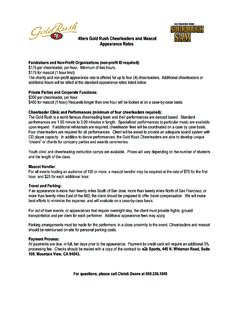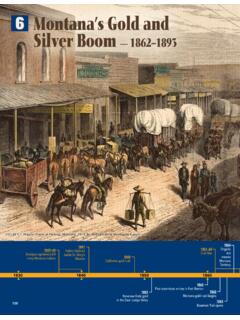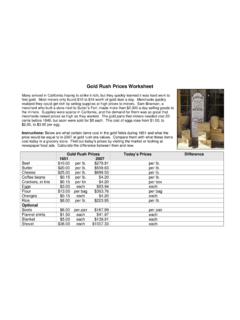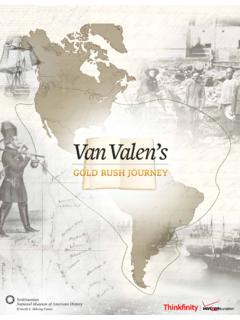Transcription of The Gold Rush and Westward Expansion
1 The gold rush and Westward Expansion In order to understand the significance of the gold rush , it is important to look back at the events that led to the discovery of gold in California. One of the most important events was the Mexican-American War (1846-48). The Mexican-American War was a war of national aggression to gain territory. It followed the 1845 annexation of Texas, which Mexico regarded as its territory. In 1836 the Texian Army won the Battle of San Jacinto against Mexican forces, led by famed general Santa Anna, and the Republic of Texas declared its independence from Mexico.
2 But Mexico had refused to acknowledge this action and warned the that if it tried to make Texas part of the , Mexico would declare war. In 1845 Texas voluntarily asked to join the , and became the 28th state. This action led to Mexico to declare war on the United States, starting the Mexican-American War. After a series of conflicts spanning two years, the United States won the war. When the dust settled, the had gained a significant amount of new territory. The region collectively known as the Mexican Cession included all of present-day California, Texas, Colorado, Arizona, New Mexico, Nevada, and Utah.
3 The signing of the Treaty of Guadalupe-Hidalgo officially ended the war on February 2, 1848. In addition to the ceded territory, Mexico gave Territorial Acquisition map, up its claims on Texas and recognized the Rio Grande River as America's southern border. At the time, the war was regarded as a major American victory over a hostile foe, but in the wake of the sectional strife of the Civil War the Mexican-American War was all but forgotten by history. But the war was pivotal in shaping our nation's future. It cemented the idea of the United States as an expansionist, transcontinental empire.
4 It fulfilled the nation's vision of Manifest Destiny creating one nation from Atlantic to Pacific. It shaped the land on which many Americans live today. And it led directly to the California gold rush . The Discovery of gold Unbeknownst to both the United States and Mexico at the time, the Treaty of Guadalupe-Hidalgo would serve to further America's growing wealth and prestige. For just six days before the treaty was signed, gold was discovered in the foothills of the Sierra Nevada Mountains in California. None of the delegates at the signing of the treaty could have imagined that the rivers and streams in California were soon to yield a fortune in gold .
5 In gold nugget. This small piece of yellow reality, neither the United States nor Mexico thought much of metal is believed to be the first piece of gold discovered in 1848 at Sutter's. Smithsonian Museum of AmericanCalifornia. The land in California was a dangerous, semi-arid History wilderness, inhabited with native tribes. The war had simply been about borders and territory not what the territory actually held. Pioneers and migrants were more likely to choose the fertile territory of Oregon than they were California.
6 gold was discovered on January 24, 1848 by John W. Marshall, a carpenter and sawmill operator who worked at Sutter's Mill, owned by pioneer and German-born immigrant John Sutter. During his early morning routine check of the water-powered sawmill, Marshall spotted a glint of gold beneath the surface of the South Fork American River. Marshall plucked the pea- sized particle from the water and recalled, I reached my hand down and picked it up; it made my heart thump, for I was certain it was gold . Marshall took his discovery to Sutter, who used an encyclopedia to confirm the find.
7 Sutter recalled the even years later in a magazine: It was a rainy afternoon when Mr. Marshall arrived at my office in the Fort, very wet.. He told me then that he had some important and interesting news which he wished to communicate secretly to me, and wished me to go with him to a place where we should not be disturbed, and where no listeners could come and hear what we had to say. I. went with him to my private rooms .. I forgot to lock the doors, and it happened that the door was opened by the clerk just at the moment when Marshall took a rag from his pocket, showing me the yellow metal; he had about two ounces of it.
8 After [reading]. the long article gold in the Encyclopedia Americana, I declared this to be gold of the finest quality, of at least 23 carats. Sutter swore his workers to secrecy, but within months the secret was out, and the gold rush was on. Newspaper reports on the discovery were initially met with disbelief, but once evidence of gold was brought into San Francisco the frenzy began. The San Francisco-based journal, The Californian, published the following on May 29, 1848: The whole country from San Francisco to Los Angeles, and from the sea shore to the base of the Sierra Nevada, resounds with the sordid cry of gold !
9 gold !! gold !!! while the field is left half planted, the house half built, and everything neglected but the manufacture of shovels and pickaxes. By mid-June 1848, three-quarters of San Francisco's male population had left the city for the foothills of the Sierra Nevada in search of gold . All of Sutter's workmen abandoned him to seek their fortunes in the rivers and streams, gripped with gold fever Sutter complained that even my cook has left me. The gold rush turned life upside down. When the news of gold reached the East coast, many men who had trained as bankers, lawyers, and doctors in the East now migrated Westward , spending their days knee-deep in freezing water, moving rocks and stones until their hands were numb searching for gold .
10 One man likened the gold fever to a highly contagious disease. Writing to his friends on the East coast he said, The whole population are going crazy .. Old as well as young are daily falling victim to the gold fever. Wives and families were abandoned, left behind to figure out ways to support themselves. Shops were boarded up. Schools were closed. Soldiers abandoned their posts. Benjamin Kloozer, a soldier stationed in California, was torn between duty to his country and the lure of gold . As a soldier his wages were six dollars a month, but mining for gold he stood to make as much as $150 per day.
